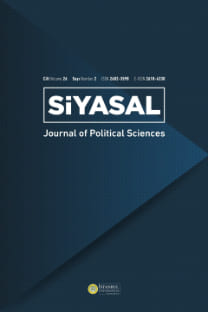Denetim kanıtlarının denetçiler tarafından değerlenmesinde kanaat fonksiyonlarının kullanımına ilişkin deneysel bir araştırma
Son yıllarda A.B.D. ve Avrupada yaşanan çeşitli şirket skandalları bağımsız denetime olan güvenisarsmıştır. Bu durum denetim riskinin yeniden tanımlanmasına neden olmuştur. Denetim amacınınsağlanması bakımından denetim kanıtlarının sağladıkları desteğin Dempster- Shafer Teorisininbir alt başlığı olan kanaat fonksiyonları ile gösterimi bu çalışmanın amacını oluşturmaktadır.Çalışmanın amacına uygun olarak biçimlendirilmiş bir denetim vakası üzerinde 63 denetçinin görüşüalınmıştır. Denetçilerin ulaştıkları yargıları göstermeleri bakımından olasılık teorisi gösterimi ilekanaat fonksiyonları gösteriminin bir mukayesesi yapılmıştır. Yapılan çalışma neticesinde denetimkanıtlarının içerdiği belirsizliği temsil edebilmesi bakımından kanaat fonksiyonlarının denetimriskinin matematiksel gösterimine daha uygun olduğu görülmüştür.
An empirical investigation about using belief functions for Auditors evaluations of audit evidence
In recent years, various corporate scandals which occured in the U.S.A. and Europe undermined thetrust of independent auditing. This situation caused to redefine the audit risk. The aim of this paperis to show the level of support that provided by the support of evidence with the presentation of theDempster-Shafer theory belief functions. According to these purposes, sixty-three Turkish auditors opinions were taken. A comparison between Bayes Theory and Dempster Shafer Theory s belieffunctions which are a better representation of the audit judgements in terms of auditors opinionswas presented. In this study, it was observed that using belief functions to evaluate audit evidenceis a better mathematical presentation of the audit risk than using Bayesian method.
___
- American Institute of Certified Public Accountants, (1983) Statement on Auditing Standarts No.39: Audit Sampling. New York: AICPA.
- American Institute of Certified Public Accountants, (1983) Statement on Auditing Standarts No.47: Audit Risk and Materiality in Conducting an Audit. New York: AICPA.
- American Institute of Certified Public Accountants, (2006a) Statement on Auditing Standarts No.107: Audit Risk and Materiality in Conducting an Audit. New York: AICPA.
- American Institute of Certified Public Accountants, (2006a) Statement on Auditing Standarts No.111: Audit Sampling. New York: AICPA.
- Arens, A.A.ve Loebbecke, J.K. (1997) Auditing: An integrated approach, 7th ed. Englewood Cliffs, USA, NJ: Prentice Hall.
- Boritz, J.E., ve Jensen R.E. (1985) An hierarchical, assertion-oriented approach to planning audit evidence-gathering procedures California, Symposium on Audit Judgment and Evidence Evaluation, University of Southern California.
- Bortiz, J.E. ve Wensley, A.K.P.(1990) Structuring the assetment of audit evidence: an expert system approach Auditing: A Journal of Practice and Theory,1:49-109.
- Desai, V., Roberts, R. ve Srivastava, R.P. (2010). A conceptual model for external auditor evaluation of the internal audit function using belief functions Contemporary Accounting Research, 27(2):537-55.
- Harrison, K., Srivastava R.P. ve Plumlee, R.D. (2002) Auditors evaluations of un- certain audit evidence: Belief functions versus probabilities R.P. Srivastava&T. Mock (EDS), Belief Functions in Business Decisions, Heilderberg: Springer-Verlag.
- Kamu gözetim Kurumu Bağımsız Denetim Standartları Taslak Metinleri (200, 220, 230, 240 ve 250), 10.06.2013, www.kgk.gov.tr/standartlar.
- Kinney, W.R. Jr. (1984) An analysis of the audit framework focussing on inherent risk and the role statistical sampling in compliance testing: Part 1 Kansas, Auditing Symposium VII, University of Kansas.
- Leslie, D.A., (1984) An analysis of the audit framework focusing on inherent risk and the role of statistical sampling in compliance testing: Part 2 Auditing Symposium VII, University of Kansas.
- Leslie, D.A., Aldersley, S.J., Cockburn, D.J. ve Reiter, C.J., (1986) An assertion based approach to auditing, Kansas, Proceeding of the 1986 Touche Ross/University of Kansas Symposium on Auditing Problems (May), ABDde sunulan bildiri.
- Mock, T., L. Sun, R. P. Srivastava ve M. Vasarhelyi (2009) An Evidential Reasoning Approach to Sarbanes-Oxley Mandated Internal Control Risk Assessment under Dempster- Shafer Theory International Journal of Accounting Information Systems, 10(2): 65-78.
- Sentz, K.ve Ferson, S. (2002) Combination of evidence in dempster-shafer theory, SAND, 8(1):1-20
- S.P.K. (12.06.2006) Sermaye Piyasasında Bağımsız Denetim Standartları Hakkında Tebliğ (Seri: X, No: 22) Ankara: Resmi Gazete (26196)
- Shafer, G.R. ve Tversky, A. (1985). Languages and designs for probability judgment Cognitive Science, 9: 309-339.
- Shafer, G.A. (1976) Mathematical Thoery of Evidence, USA, Princeton University Press, Princeton NJ.
- Srivastava S.P. ve Shafer, G.R. (1992) Belief-function formulas for audit risk The Accounting Review , 67:249-283.
- Srivastava, R. P. (2011) An introduction to evidential reasoning for decision making under uncertainty: Bayesian and belief functions perspectives . International Journal of Accounting Information Systems, 12:126135.
- Srivastava, R. P., Mock, T.J. ve Gao, L. (2011) The Dempster-Shafer theory of belief functions for managing uncertainties: An introduction and fraud risk assessment illustration Australian Accounting Review , 21(3):282291.
- Srivastava, R.P. ve Shafer G.R.(1995) A general scheme for aggregating evidence in auditing:Propagation of beliefs in networks Artificial Intelligence in Accounting and Auditing, 3:18-48.
- Srivastava, R.P., Dutta, S.K. ve Johns, R.W. (1996). An expert system approach to audit planning and evaluation in the belief-function framework Intelligent Systems in Accounting, Finance and Management, 5:165-183.
- Srivastava, R.P., Mock, T.J. ve Turner., J. (2007) Analytical formulas for risk assessment for a class of problems where Risk depends on three interrelated variables International Journal of Approximate Reasoning, 45:123-151.
- T.C. Yasalar (13.01.2011) 6102 Sayılı Yeni Türk Ticaret Kanunu. Ankara: Resmi Gazete (27846).
- Teymur, C., (2008) Kural Tabanlı Karar Verme Sistemlerinde Belirsizliğin Modellenmesi (Yayınlanmamış Doktora Tezi), İstanbul, İ.T.Ü.
- Turner, J., Mock, T.J. ve Srivastava, R.P., (2002) A formal framework of auditor independence risk Australian Accounting Review, 27, 12(2):31-38.
- Wang, Li. X. (1997) A Course in Fuzzy Systems and Control, USA, Prentice-Hall.
- ISSN: 1303-1260
- Yayın Aralığı: Yılda 2 Sayı
- Yayıncı: İstanbul Üniversitesi
Sayıdaki Diğer Makaleler
Yerel aktörlerin gözünden yerel özerklik sorunsalı: Türkiye'de il Belediyeleri örneği
Uğur ÖMÜRGÖNÜLŞEN, Uğur SADİOĞLU
Sosyal hizmetler bağlamında SHÇEK'in taşra teşkilatının il özel idaresine devri sorunu
An Essay on economic thought inspired by first philosophy
Güncel sosyal bilimler felsefesine dair bir tartışma: Öznenin ölümü ve sonrası
Güven Gürkan ÖZTAN, Cemile Burcu KARTAL
Hırvatistan tarih ders kitaplarında Osmanlı- Türk İmajı
Leonid Kuchma dönemi Türkiye Ukrayna ilişkileri yapıcı ortaklık
